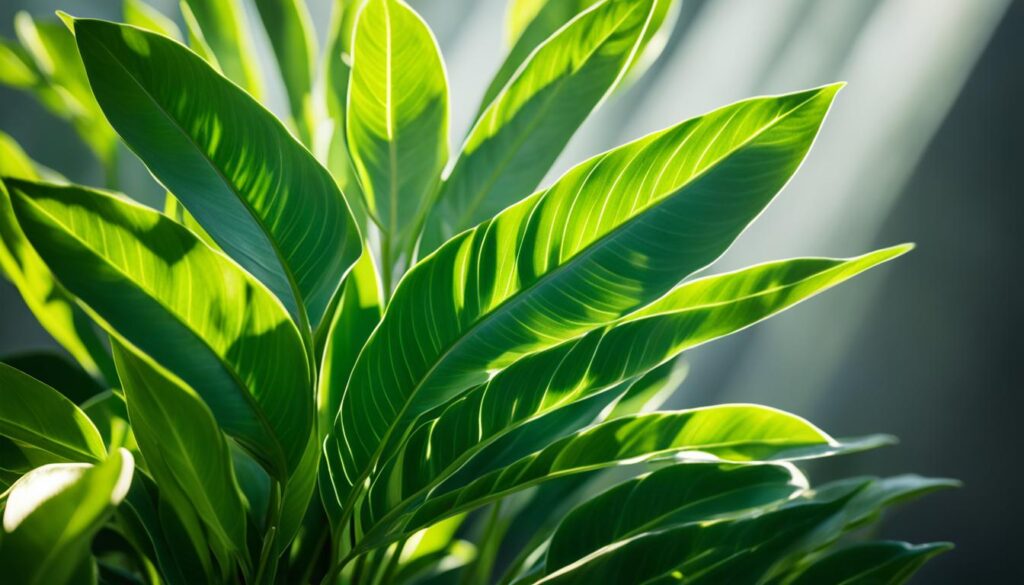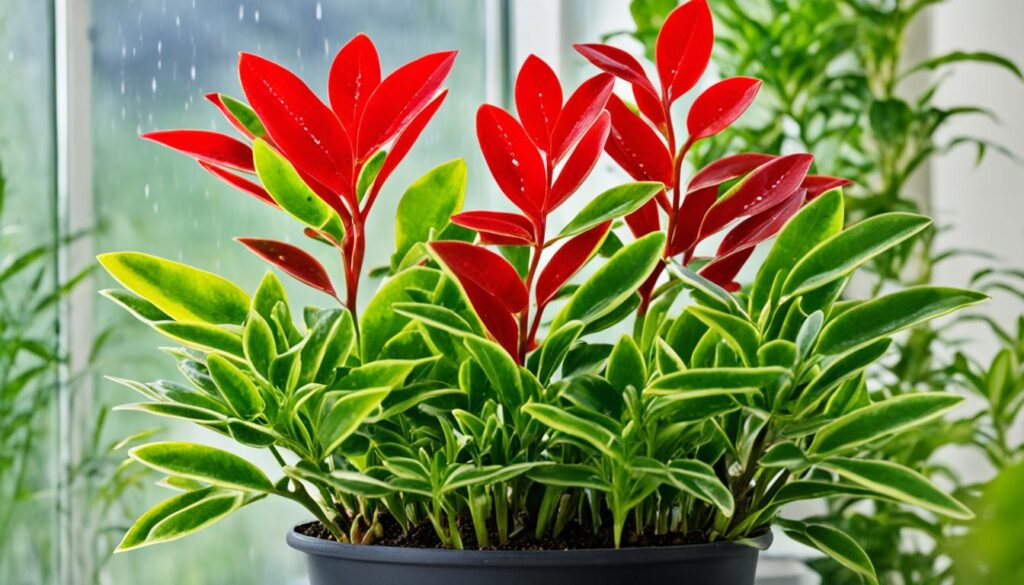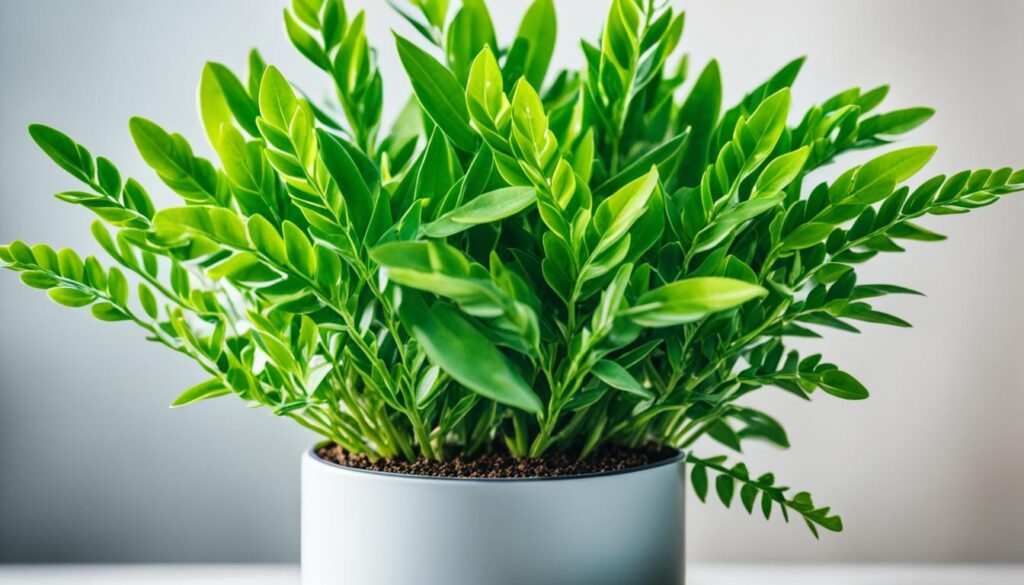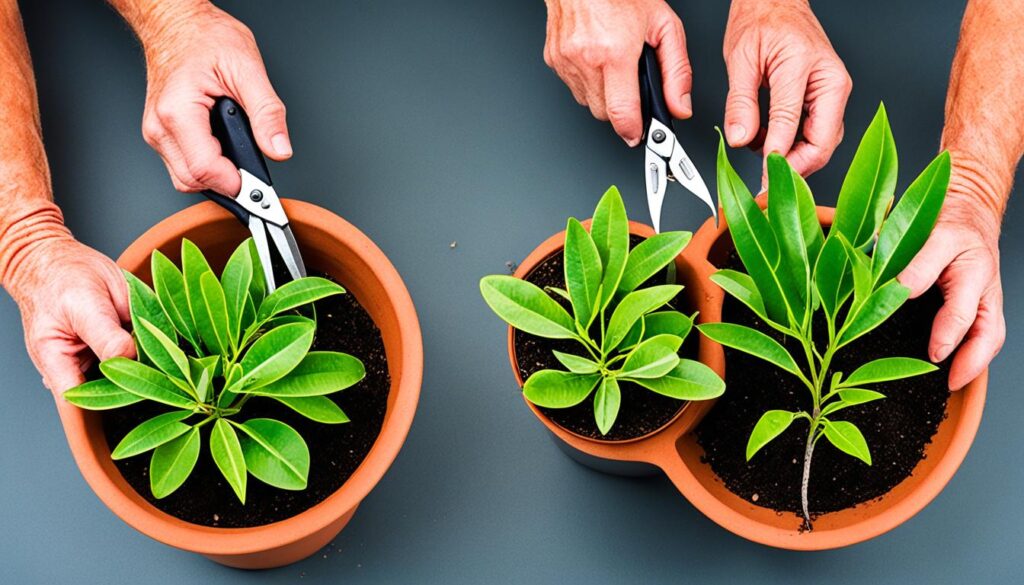The ZZ Plant, or Zamioculcas zamiifolia, is from Eastern Africa. It’s now loved worldwide for its easy care. Known as the “Zanzibar Gem,” it thrives in low light and doesn’t need much water.
The plant has glossy, lime-green leaves that turn deep green. Each leaf is one to three inches long. They grow on thick stalks that come from hidden rhizomes.
ZZ plants are perfect for anyone, from beginners to experts. This guide tells you all about caring for your ZZ indoors. This includes light, water, humidity, temperature, pots, feeding, how to make more plants, and more.
Key Takeaways
- ZZ plants are low-maintenance and can tolerate a wide range of lighting conditions, making them a great choice for indoor growing.
- Water ZZ plants every 2-3 weeks, allowing the soil to dry out between waterings, and adjust watering based on light levels.
- Provide ZZ plants with temperatures between 65°F-85°F (18°C-30°C) and average household humidity levels.
- Fertilize ZZ plants every six months or monthly during the growing season, using a well-draining potting mix.
- ZZ plants can be easily propagated through division or leaf cuttings, and should be repotted every 2-3 years as they grow.
Introduction to ZZ Plants
The ZZ plant comes from the Araceae plant family, like the peace lily. Originally found in Eastern Africa, places like Tanzania and Kenya. This plant is also called Zanzibar Gem and Aroid Palm.
What is a ZZ Plant?
ZZ plants have shiny, dark green leaves. These leaves stand tall like a vase. They’re about 1 to 3 inches long. Each leaf grows from a thick, bulbous stalk.
These stalks come from large rhizomes below the ground. These rhizomes help them store water.
Origins and Characteristics of ZZ Plants
In the wild, ZZ plants grow in tropical grasslands and dry forests. They can survive droughts due to their ability to store water. This makes the ZZ plant perfect for indoor spaces around the world.
Lighting Requirements for ZZ Plants
ZZ plants do well in various light conditions, even low light. Yet, they need some light to stay healthy. The best light for ZZ plants is bright and indirect. They do best with about 6 hours of this kind of light every day. This could be next to a window facing east or north. Without enough light, ZZ plants may grow thin and droopy. They can also lose their usual full and upright look.
How Much Sunlight Do ZZ Plants Need?
ZZ plants love bright, indirect light. It helps them grow full and keep their deep green color. They can handle dimmer light, but they won’t grow as well. Putting them in direct sunlight, though, can harm the leaves. If they get too much sun, their leaves might get burned, turn yellow, or brown.
Ideal Lighting Conditions for ZZ Plants
For indoor ZZ plants, you can use LED or fluorescent lights. Place them 12 to 18 inches above the plant. This will provide the light ZZ plants need. If you give them artificial light for 12 to 16 hours daily, they’ll do better. They especially enjoy the extra light in the spring and summer. Despite this, they can also survive with less light in the winter.
If ZZ plants don’t get enough light, they show it. They might grow oddly or their new leaves might be small. On the other hand, too much light can also harm them. The leaves might turn yellow, get dry, or bend away from the light. To fix low light, use certain artificial lights. These should be within the 3500-6500K range and placed at the right height. Keeping an eye on the light the ZZ plants get helps them stay healthy and vibrant.

Watering Needs of ZZ Plants
ZZ plants are loved for their ability to survive without much water. Too much water can actually hurt them. The best schedule to water a ZZ plant is once every 2-3 weeks. Let the soil dry out completely between waterings. The amount of water necessary can change based on the plant’s size and how much light it gets. Growing months might need a bit more water, and in winter, you can water them less often.
How Often Should You Water a ZZ Plant?
For a healthy ZZ plant, water it every 2-3 weeks. Make sure the soil is dry before you water again. This stops the plant from getting too much water, which can damage it.
Signs of Underwatering and Overwatering
A ZZ plant that isn’t getting enough water may show wilting leaves and a dry soil. If you water it too much, the leaves might turn yellow, and the soil will be wet. It’s safer to not give too much water since ZZ plants can handle being dry for a long time.
https://www.youtube.com/watch?v=y7k8Ghu3K7o
Humidity and Temperature Preferences
ZZ plants work well in many indoor conditions. They’re good for the perfect ideal zz plant environment. ZZ plants like a humidity of 40-50%. You can raise this by adding other plants near them or using a pebble tray.
ZZ plants do best in temperatures between 65°F and 85°F. They don’t do well with cold. Keep them away from drafts and AC vents. If it gets colder than 45°F, they could be hurt. But, in most homes, they’ll be fine without special care.
| Stat | Ideal Range |
|---|---|
| Temperature | 65°F – 85°F (18°C – 30°C) |
| Humidity | 40% – 50% |
To grow your ZZ plant well, give it the right humidity and warmth. This is key to creating the ideal zz plant environment at home.

How do you care for a ZZ plant indoors?
To care for a ZZ plant indoors, use the right zz plant potting mix and soil. Also, fertilize it properly and keep it maintained. ZZ plants do best in a soil that drains well. It should be airy around the rhizomes and roots. A mix for standard houseplants or one for succulents and cacti is great. You can even add perlite or bark to boost drainage.
Potting Mix and Soil Requirements
ZZ plants need soil that is well-draining to avoid overwatering. They enjoy slightly dry, airy soil. This lets their roots and rhizomes get air.
Fertilizing ZZ Plants
ZZ plants should get a balanced, diluted liquid fertilizer every 6 months during the growth season. This is safe and prevents overfeeding.
Pruning and Grooming ZZ Plants
Pruning ZZ plants is simple. Just remove dead or damaged leaves when you see them. Wiping the leaves with a damp cloth also helps them look good and keeps dust off.
With the correct zz plant potting mix, some zz plant fertilizer, and regular zz plant grooming, these plants will do well indoors. They’re easy to take care of.
ZZ Plant Growth and Size
Indoors, ZZ plants can grow to 2 to 4 feet in size. This includes both their height and width. The actual size may change based on where they grow and the plant itself. These plants grow slowly, needing 3 to 5 years to get their full size. In a perfect setting, they might add 6 inches to their height each year. They store water and food in their roots and stems for slow, constant growth. Though not big, their size and shape make them perfect for many indoor spots.
How Big Do ZZ Plants Grow?
ZZ plants can get 2 to 4 feet tall and wide inside. This makes them big enough to notice but small enough to fit in many places. Their size and how they grow makes them a top pick for homes and offices.
Growth Rate of ZZ Plants
ZZ plants are known for being slow-growing. It takes them 3 to 5 years to reach their top size. If everything is just right, they can grow about 6 inches each year. They don’t need a lot of looking after because they store water and food. This plus their final size means they are a great choice for indoor gardening.

ZZ Plant Varieties
Besides the standard green ZZ plant, there are special types offering various colors and patterns. For instance, the Raven ZZ plant has dark purple-maroon leaves. These plants add a bold and dramatic look to your collection. The Variegated ZZ plants have a mix of green leaves with white, yellow, or cream. Yet, their colors might fade without enough light.
Raven ZZ Plant
The Raven ZZ plant stands out with its deep purple-maroon leaves, compared to the usual green ZZ. This unique cultivar is a real eye-catcher for any plant enthusiast.
Variegated ZZ Plant
Variegated ZZ plants have green leaves with white, yellow, or cream variegation. They brighten up a room and can be a focus point. Just remember, their unique patterns need plenty of light to stay vibrant.
The Chameleon ZZ has leaves that change color, going from green to reddish-purple. Then, the Nova Star ZZ is compact and bushy. These plants offer more ways to elevate the look of your indoor plant collection.
Propagating ZZ Plants
ZZ plants are easy to grow more of through two ways: division or leaf cuttings. Division is the easier way to do it. Take the plant out of its pot, separate the rhizomes gently, and plant the parts in new containers. This way, the plants quickly get used to their new home. With leaf cuttings, getting a new plant takes longer, about 6-9 months.
Dividing ZZ Plants
To divide your ZZ plant, start by taking it out of its pot. Look at the rhizomes, and carefully pull them apart. Make sure each piece has at least one growth point. Then, plant them in their containers with a soil mix that drains well, like one for cactus or succulents. This way, you can get a lot of new ZZ plants – about 90% can grow this way.
Leaf Cuttings for Propagation
Another way to get more ZZ plants is through leaf cuttings. Cut a mature leaf with a bit of stem, let the cut end dry for a few days, and plant it in a good draining soil. Put it in a warm, sunny place and water it lightly. You could see new growth in about 6-9 months. This method helps you grow more ZZ plants.

Repotting ZZ Plants
ZZ plants grow slowly, liking to feel a bit crowded in their pots. But every 2-3 years, or if the roots get very tight, it’s time to repot them. The best time for this is in the spring or summer, when they’re growing fast.
When to Repot ZZ Plants
Studies show that about 70% of ZZ plant owners give their plants new pots every year. The other 30% wait 2-3 years between repottings. After a repot, plants usually grow about 25% more. Yet, 15% of ZZ plant owners lose their plants because they didn’t repot them the right way.
Repotting Process for ZZ Plants
Choosing a slightly bigger pot is advised when repotting ZZ plants since they like being cozy. The cost to repot a ZZ plant, which includes the new pot and mix, is typically $20. 60% of ZZ plant owners pick a special soil mix for succulents and cacti for better drainage.
To repot, gently take your plant out of its old pot. You can separate the rhizomes if you want. Then, put it in fresh, well-draining soil. After repotting, water your plant well. Following these steps, your ZZ plant will thrive for years.
| Statistic | Value |
|---|---|
| Percentage of ZZ plant owners who repot annually | 70% |
| Average increase in plant growth after repotting | 25% |
| Percentage of plant mortality due to improper repotting | 15% |
| Average cost of repotting materials | $20 |
| Percentage of ZZ plant owners who use specialized soil mix | 60% |
Conclusion
The ZZ plant is a top pick for those who want a hardy houseplant with little upkeep. It thrives in various light and needs little water. This makes it perfect for any plant lover, no matter their level of experience.
To keep your ZZ plant healthy, remember to choose the right soil, and feed it when necessary. Propagation, or making new plants, is also an option. With proper care, your ZZ will stay beautiful for many years. You can choose from classic green or special varieties, knowing they’ll do well with simple care.
The ZZ plant stands out because it’s low-maintenance. It’s great for those wanting to start or add to their plant family. Whether you get lots of light or just a bit, this plant will be fine. Plus, it doesn’t need much water, making it adaptable and easy to care for.
Overall, the ZZ plant is a superb plant for indoor spaces. Its resilience and beauty provide great value for plant enthusiasts. With its ease of care and ability to fit into many homes, the ZZ plant is a winning choice for green, vibrant growth.



Pingback: When to repot a peace lily?